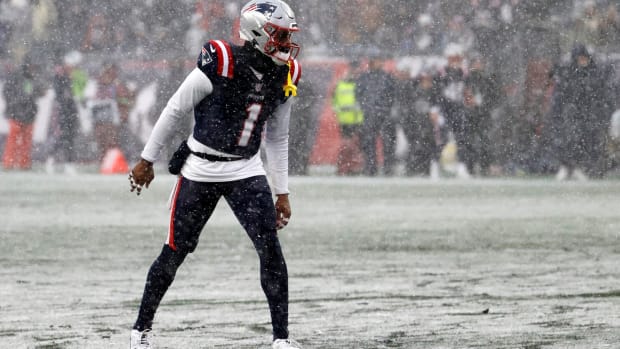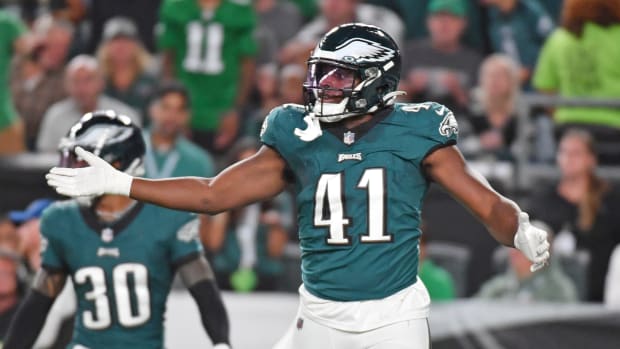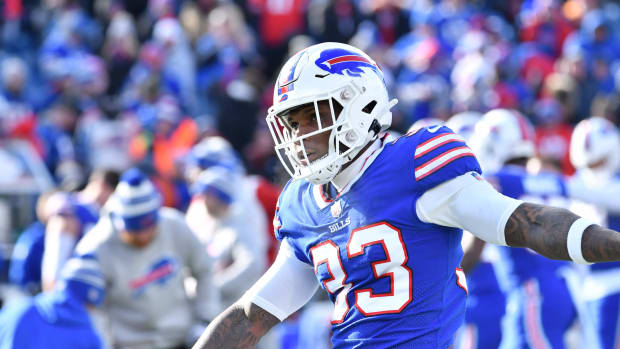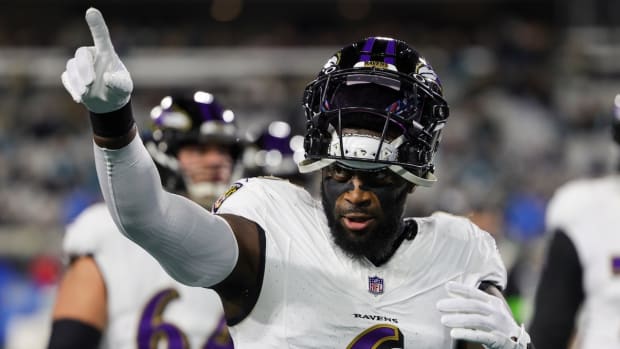
Why the AFC North is Football’s Crown Jewel
CLEVELAND — How tightknit is the AFC North? Before they were rivals, Browns coach Mike Pettine coached under Ravens boss John Harbaugh in Baltimore, where Marvin Lewis had served as the defensive coordinator before taking over the Bengals. Beyond football, their lives are so intertwined that Harbaugh and Pettine even go to girls’ lacrosse games together. Or, to be more precise, they went to the same lacrosse tournament in Maryland and chatted as their teenage daughters played in separate games.
These friendships, after all, have their limits.
“We’re all competitors,” Pettine says, “so I don’t want to say you’re being fake in pregame, but you look a guy in the eye, shake his hand, ask him about his family, and in your mind you’re going, I’m gonna beat your brains in.”
Going into Week 15, all four AFC North teams—Baltimore, Cincinnati, Cleveland and Pittsburgh—had winning records and legitimate playoff hopes. That had never happened before in the division, or in its predecessor, the Central. With two weeks left in the regular season, there’s only been one series sweep: Cincy twice edged Baltimore by one-score margins.
A year ago, the NFC West was put on a pedestal as the NFL’s most celebrated division. Here are four reasons why that distinction should now belong to the AFC North.
It’s not so friendly
Despite all the familiar faces, there’s a league-wide sense that AFC North guys will do almost anything to gain an advantage. All four rosters are littered with players who have recent experience with a division rival. Two guys—Steelers quarterback Bruce Gradkowski and Bengals running back Cedric Peerman— have played for three division teams, which isn’t totally uncommon.
But this is: “It’s gotten to the point in that division where you’re afraid to cut a guy, especially a quarterback, the week before you play a team for fear the other team might sign him,” says NFL Network analyst Daniel Jeremiah, a former Ravens and Browns scout. “Coaches will bring in a guy the week of a game to learn the audibles and signals, so you end up holding onto a player you might have cut during a division game week and that practice squad player you wanted to elevate just has to wait.”
So you can imagine the dilemma Bengals coaches faced last week when preparing for Johnny Manziel’s first start, knowing nothing about how the Browns might use the rookie quarterback whose style of play is so disparate from Brian Hoyer’s.
“Our coordinator told us he did not know what to expect, and we ended up watching some college tape,” says Bengals linebacker Rey Maualuga. “That was a first.”
Which brings us to our next point.
The coaching
The argument can be made that the AFC North got the largest boost in coaching acumen last offseason. Cleveland cleaned house (again), adding Pettine, who has squeezed seven wins out of the only AFC North team with a never-ending quarterback controversy. The Steelers, after hiring former Titans head coach Mike Munchak to oversee the offensive line, have gone from 3.5 yards per rushing attempt in 2013 to 4.4 this season. Baltimore added former Texans head coach Gary Kubiak as its offensive coordinator, doing wonders for the running game despite losing Ray Rice. Pettine’s offensive coordinator, Kyle Shanahan, grew up under Kubiak in Houston before taking the coordinator job in Washington, where he tutored Robert Griffin III during his Rookie of the Year effort.
And that’s exactly where Bengals defensive coordinator Paul Guenther started preparing for Manziel, figuring Shanahan would start off Johnny Football in the same manner he successfully guided another passer with a similar skillset. On Saturday night, Guenther showed his unit last year’s LSU-Texas A&M game, believing the Tigers provided the toughest competition for Manziel and showed exploitable flaws.
“Coach wanted to show us what he does under pressure,” says Bengals defensive tackle Domato Peko. “One of Manziel’s favorite things is to spin out and escape to the left, and he likes to escape up the middle, so we made sure to push the pocket and bull-rush the defensive ends. We got him on his back early in the game and kind of set the tone.”
This is football
No, it’s not sexy football. It’s just really good football. The AFC North doesn’t have Aaron Rodgers or any of the four or five quarterbacks you might consider to be in the upper echelon of the position. The offenses aren’t high-flying (with the exception of Pittsburgh) but each ranks in the top 18 in rushing yards and sacks allowed, and in the top 20 for fewest turnovers allowed. The defenses—aggressive, intelligent and opportunistic—each rank in the top 20 in turnovers forced.
The architecture of the rosters explains why.
These teams aren’t blowing cash on fancy wide receivers or cornerbacks—prized commodities in the illegal contact era. They’re winning games by investing in the front seven and young running backs. On average, AFC North teams spent just under 25 million against the cap on starting defensive rushers in 2014. AFC East teams, for instance, averaged 18 million on starting rushers (13 million if you remove Mario Williams’ mega-contract with the Bills from the equation). And of the 21 running backs drafted in the first three rounds over the last three drafts, seven have gone to the AFC North. (That’s a third of the haul going to just one-eighth of the league.)
“You have to build your team around what you’re going to see on a weekly basis,” says Browns linebacker Paul Kruger, who signed a $40 million deal to leave Baltimore for Cleveland in 2013. “A lot of teams have taken the same approach in scouting. You have to have a game plan that allows you to defend consistently what teams in your division are doing.”
“It’s probably not smash-mouth like it was before, because of rule changes,” says Browns cornerback Joe Haden. “But it’s physical, it’s hard-hitting.”
And it’s loud
Ravens defensive tackle Chris Canty knew what he was getting into when he left the Giants and signed with Baltimore two years ago.
“When I came down here in 2012 as a Giant, I was just taken aback by the atmosphere,” he says. “This is something I had never seen, and it wasn’t even a rivalry game. When we play the Steelers in Baltimore, it’s a completely different experience than the rest of the NFL.”
The same could be said of the Bengals and Browns’ Battle of Ohio last Sunday … but only for about 15 minutes. The buzz dropped out of the stadium after Manziel’s first series, a three-and-out. By the second quarter, fans were streaming into the parking lots along Lake Erie. One heroic young Browns fan in a Joe Haden jersey stayed long enough to deny Bengals running back Jeremy Hill a celebratory hurdle into the arms of a Bengals fan in the stands. On Monday, a glum Pettine said the young man ought to be “commended” for his actions.
It spoke to the bitterness of the rivalry, and to the Browns’ recent refusal to be the AFC North’s doormat. That quest seems to be in serious jeopardy after getting shut out, 30-0, with the quarterback of the future managing only 80 yards while throwing two interceptions. Some will attribute Cleveland’s overall success—and the success of the division at large—to its non-conference schedule against the AFC South and NFC South, which have a combined seven (out of eight) teams at or below .500. (Through Week 15, the AFC North has a .681 winning percentage against non-division teams; since 1970, the best mark belongs to the 1984 AFC West, which went .775 outside the division.)
It may take yet another full season to prove what Pettine believes to be true.
“I think it’s the best division in football,” he said after a media peppering on Monday. “Hopefully we’ll get out there and prove that.”
Follow The MMQB on Facebook, Twitter and Instagram.
[widget widget_name="SI Newsletter Widget”]





































